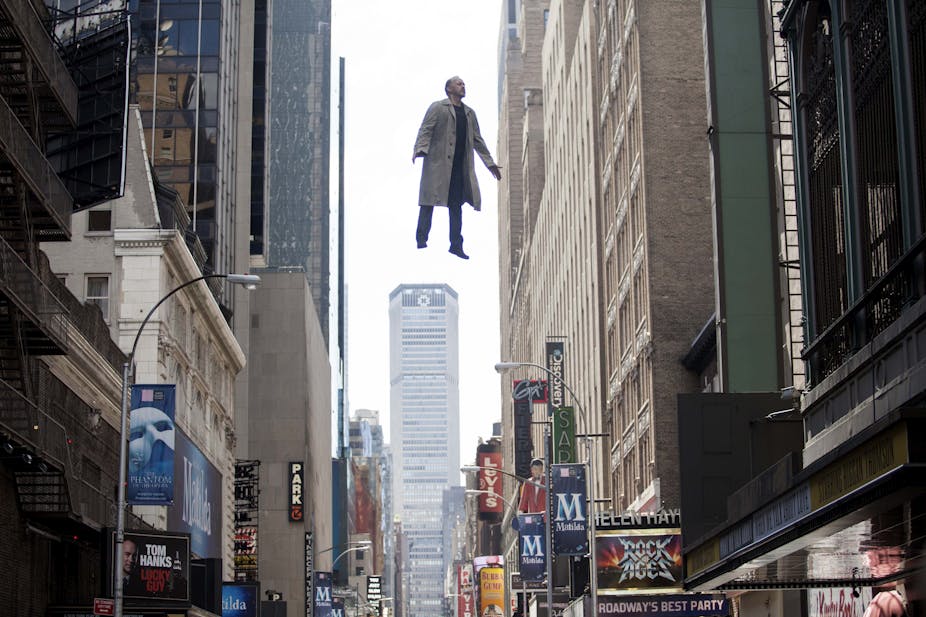What do Shakespeare’s Hamlet, The Simpsons, and Alejandro G. Iñárritu’s film Birdman have in common?
All three utilise the concept of meta-theatre. The concept of meta-theatre, or meta-text, in its crudest definition, denotes an additional layer of meaning that is added onto a text.
In the context of the stage, a performance-within-a-play is an example of a meta-text. William Shakespeare utilises meta-theatre in several of his plays, including The Tempest, King Lear, A Midsummer Night’s Dream and Hamlet.
Meta-theatre can also be used as a form of parody or satire. In The Simpsons, the parody of classic Tom and Jerry cartoons, the cartoon-within-a-cartoon (The Itchy and Scratchy Show) is used to parallel the plots of certain episodes.
Birdman, as with Hamlet and The Simpsons, is a gripping dark comedy that is also centred on the concept of meta-theatre. In an interview regarding his role in Birdman, Michael Keaton notes that:
The film has so many levels. Then the levels have levels.
Levels of Birdman
The film’s most basic “level” is its core plot of a washed-out action star trying to make a comeback via the stage.
Birdman is a bold statement about contemporary stage, screen and celebrity culture, ambitiously crafted in the semblance of a single take. At the heart of Iñárritu’s narrative is Keaton’s character Riggan’s efforts to direct and star in a play-within-a-movie, an adaptation of Raymond Carver’s short story, What We Talk About When We Talk About Love.
But the layers of meta-textuality in Iñárritu’s film serve as a red herring, a distraction from the text’s astonishingly simple yet alluring narrative of an individual’s struggle for recognition.
The first notable layer of meta-textuality is the obvious parallel between Michael Keaton’s role as Bruce Wayne/ Batman in Tim Burton’s Batman franchise, and his role as Riggan Thomson/ Birdman. It is thus tempting to read the film as a meta-commentary on Michael Keaton as a former A-list Hollywood star.
At the height of the Tim Burton Batman film franchise in the 90s, it was Keaton who walked away. He reportedly turned down a role in Batman Forever because he felt it was “awful”, even though he was rumoured to have been offered US$15 million to play the role.
In Birdman, Keaton’s character refused to star in a planned third sequel to the fictional Birdman franchise. The parallels between Keaton/ Riggan and Batman/ Birdman are also tapped into by Fox Searchlight as part of a marketing strategy.
Beyond Keaton?
But despite this reel/ real life parallel, Keaton’s co-star Edward Norton points out the comparison between Birdman and Batman is superficial:
It [the film] is really of a person coming unhinged and coming to grips with the fact that everything that’s gone wrong in his life is may in fact have to do with his own ego and not what other people have done to him and that’s, that’s a very much more nuanced, you know, character study than I think just this kind of glib comparison people are making to the role.
In Birdman, audiences are prompted to look at Keaton alongside the character of Riggan, but Norton tells us to look beyond this. Ironically, a scene from the film reads as a reference of sorts to Norton’s iconic role in David Fincher’s Fight Club (1999), a film that also interrogates themes of identity in crisis.
Whether this reference is deliberate or not is up to the audience to decide.
Keaton, like Norton, is quick to downplay trite parallels between real life and screen character.
In terms of the parallels, I’ve never related less to a character than Riggan but I did understand him on a lot of levels because he was so visceral and true and heartbreakingly human.
Keaton’s remarks here point to the core of the film.
And yes, what stands out in Iñárritu’s characterisation of Riggan is his humanity. He is an anti-hero and an everyman who elicits our sympathy because his actions strike us as real. He is a father, a colleague, a co-investor, an ex-husband, an actor, a lover, a neurotic, and an alcoholic.

Iñárritu’s meta-theatre reveals the complex duality of Riggan’s relationship with his collaborators. His assistant is his daughter. His emotional attorney is his old friend. His rival doubles up as his leading star. These relationships create an emotional canvas on which Riggan is painted as more human than superhuman.
Carver’s contribution
Through the film’s play-within-a-movie, Riggan’s frustrations and frailties are laid bare for the audience. A host of meta-textual layers connect Riggan and the character he plays in What We Talk About When We Talk About Love.
Carver’s short story features four friends sharing stories with each other, one of which revolves around a failed suicide. This is referenced via Riggan’s multiple suicide attempts.
And, of course, Iñárritu’s film is a symbolic meta-textual reference to the superhero narrative itself.
As a result of one of his suicide attempts, Riggan is forced to don a mask, a situation that is foreshadowed by shots of Phantom of the Opera signs on Broadway.
This leads to the culmination of a narrative of refusal, redemption and transcendence, one that is epitomised by the last shot of the film. Riggan’s daughter looks out of the hospital window, stares at the ground – and then looks up at the skies. For a moment, it seems that Riggan, at least to his daughter, has become Birdman.
And here, under all the layers, lies the heart of Iñárritu’s story: that everyone struggles for recognition, a super-human process that is hard and that requires sacrifice.

